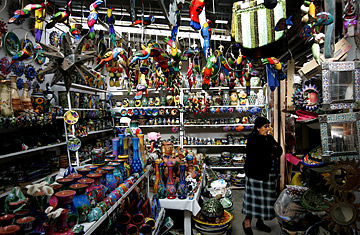
A vendor waits for customers at an artisan market in Rosarito, Mexico. The tourist industry in some Northern Mexican resort towns is feeling the effects of the ongoing drug war.
(3 of 5)
But Hummers filled with stern-faced soldiers and .50 caliber machine guns is not the post-card image tourists seek, nor a perception easily changed —unless of course you live in Rosarito. "The military has really made a huge difference," said Kanoa Biondolillo, co-owner of Baja123 real estate. "There's been a huge drop in local extortion, you don't have to bribe the police anymore if they stop you. I've never felt safer."
In 2007, Biondolillo says there were 50 or more real estate offices in Rosarito Beach; today there are 12. "We've really gotten beaten up in the American press, people think it's a war zone, but it's not. The violence is only in targeted areas, where the cartels are."
Well, not exactly. Rosarito has had its share of death, particularly late last year when a war broke out between rival factions of the Arrelano drug cartel and when federal, state and city officials cracked down. More than 30 people, mainly cartel members, were killed in Rosarito. Since then Torres has installed a new Tourist Police Force, some 38 uniformed men, to reassure tourists that things are being patrolled. He's also working with the area's three key tourist centers, Tijuana, Rosarito Beach and Ensenada, to re-brand the region as "The Baja Coast," in a $1.6 million marketing campaign.
